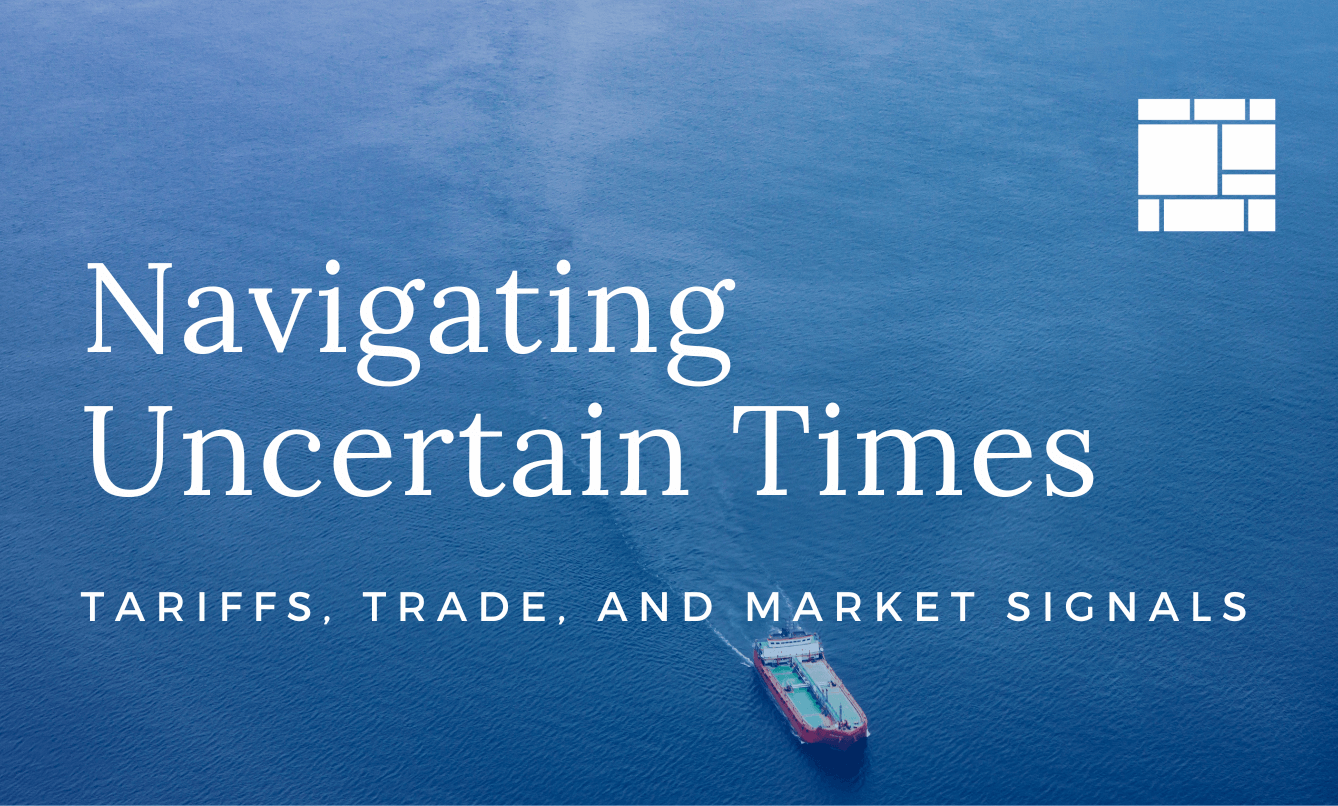Earlier this month, the announcement of unexpectedly high tariffs triggered market declines and renewed investor questions about the outlook for the U.S. economy. To explore these themes, Pathstone recently hosted a private client event featuring senior leaders and a policy strategist known for his expertise at the intersection of financial markets and government action. While the full conversation remains exclusive to Pathstone clients, we’re sharing below a few key themes from the discussion that can help contextualize the shifting trade landscape and the broader implications for portfolio positioning.
The following summary is a synthesis of the discussion and market observations and is not a direct transcript or attribution of any individual speaker.
Tariff Strategy
- China. The tariffs on China are much higher than the rest of the world. In fact, they’re about 145% right now [as of April 16].
- Canada and Mexico. Goods covered under the USMCA, or NAFTA 2.0, trade agreement are not subject to the 10% across-the-board tariffs that have been introduced. This could be a major positive for Mexico if manufacturers move there from, say, Vietnam.
- Sectoral tariffs. More attention is expected to come on autos, pharmaceuticals, semiconductors – sectors that fuel trade deficits with the U.S. and that President Trump wants to bring back to, or closer to, the U.S.
- Materials. Steel, aluminum, lumber and copper are important for the construction industry.
- Universal tariff on all goods coming into the country. This last and most surprising category gets to the heart of current concerns. Trump has noted that $21 trillion dollars of capital has left the American economy over the past 30 years, cutting U.S. workers out of the massive increase in wealth that we’ve seen since the Berlin wall came down. He believes putting tariffs on all goods coming into the U.S. would encourage manufacturing to move back or at least closer.
There’s also a national security component embedded in this strategy, with calls to bring the production of essential goods, like pharmaceuticals and defense-related materials, back within U.S. borders.
Geopolitical Considerations
Tariffs can also be seen as a tool in the administration’s geopolitical strategy, particularly against China. The goal is to reduce the trade deficit and form alliances with countries like Japan and Vietnam to counterbalance China’s influence.
President Trump has expressed his belief that there’s a greater geopolitical challenge to the United States today than at any time since the end of the Cold War. His focus on Greenland and concerns about the Panama Canal reflect this belief, as does the focus on reducing reliance on China. When Trump started putting tariffs on China in 2018, 21% of all imports coming into the United States were from China; today that number is 12%, and it appears the administration is determined to push that number lower.
Meanwhile, the surprisingly high tariffs announced in early April have spurred varying reactions. Notably, Japan, South Korea, and Vietnam have expressed willingness to negotiate; Mexico has indicated it will put its own higher tariffs on Chinese goods. If the administration can make some real progress on one or two of these trade deals, it could start giving confidence to the market that there is a plan, and they are executing on that plan.
Strategy Risks
The Trump administration has noted that the U.S. has a negotiating advantage based on the importance of our consumers to global markets. Not all trade partners are lining up, however. For example, the European Union has been clear about its openness to working with China, and Canada’s reaction has been far from mild.
China is responding to being increasingly shut out of the U.S. market by stopping sales of the critical minerals that our U.S. Defense Department needs and our tech companies need. There’s also a risk of trading partners forming coalitions outside the U.S. A few days before the April 2nd announcement, China put out a statement saying that they’re going to work with Japan and South Korea – a highly unusual development. EU delegations are expected to visit China as well.
The U.S.’s ~$300 billion trade surplus in services could also be at risk from retaliation. The EU is talking about a digital goods tax, for instance. There could be antitrust and leveling down of American companies. Tourism is another issue, with the possibility that travelers choose other destinations or companies stop holding events in the U.S.
Tariffs in Context of Strategy
Treasury Secretary Scott Bessent has laid out a three-legged policy stool: tariffs around trade, a deficit and debt plan, and deregulation and tax cuts. While tariffs have been the focus of headlines, these two other parts of the strategy are also important. If the administration were to accelerate tax cuts and deregulation while moderating its approach to timing and severity of tariffs, the outlook for the U.S. economy could rebound.
The April 2nd tariffs have created a new urgency for larger, pro-growth tax cuts and that spending cuts, while extremely difficult to achieve in Washington, may help offset some of the impact of the tariffs as well as begin to bring down the federal deficit. There is likely to be significant reductions in the need for debt issuance this year.
Optimism for the U.S.
The conversation concluded on a note of optimism despite the near-term disruptions and the damage to global relationships stemming from the administration’s handling of its tariff rollout. If execution on all three legs of the policy stool is timed well, the U.S. economy could avoid recession and continue to attract foreign investors despite shifting trade relationships. Further, while sentiment is poor and could remain so for some time, other periods in recent decades with this level of policy uncertainty were followed by robust S&P 500 returns six to 12 months later. This is not guaranteed to happen again, but periods of structural readjustment and the associated volatility can lead to restored confidence and renewed growth.
If you have any questions or would like to discuss the key takeaways on rising U.S. tariffs, shifting trade policy, and their implications for markets, sectors, and portfolio strategy, please contact us.
Disclosures
This presentation and its content are for informational and educational purposes only and should not be used as the basis for any investment decision. The information contained herein is based on publicly available sources believed to be reliable but not a representation, expressed or implied, as to its accuracy, completeness or correctness. No information available through this communication is intended or should be construed as any advice, recommendation or endorsement from us as to any legal, tax, investment or other matters, nor shall be considered a solicitation or offer to buy or sell any security, future, option or other financial instrument or to offer or provide any investment advice or service to any person in any jurisdiction. Nothing contained in this communication constitutes investment advice or offers any opinion with respect to the suitability of any security, and this communication has no regard to the specific investment objectives, financial situation and particular needs of any specific recipient. Past performance is no guarantee of future results. Additional information and disclosure on Pathstone is available via our Form ADV Part 2A, which is available upon request or at www.adviserinfo.sec.gov.







